Search
Remove Ads
Advertisement
Summary 
Loading AI-generated summary based on World History Encyclopedia articles ...
Search Results
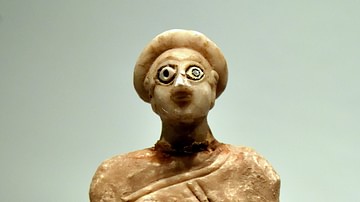
Article
Lost Treasures From Iraq: Revisited & Identified
For how long do we build a household? For how long do we seal a document? For how long do brothers share the inheritance? For how long is there to be jealousy in the land(?)? The Epic of Gilgamesh, chapter 10, Tablet X. I have always...
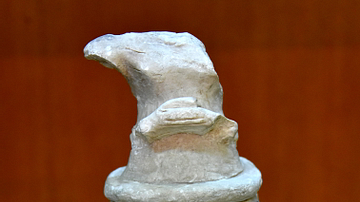
Image
Kilted Woman from Khafajah
Limestone statue of a Sumerian female. The head/neck, both arms and forearms, and the feet are lost. Only the clasped hands (in a gesture of prayer), in front of the lower chest, have survived. The upper half of the body is naked; the breasts...
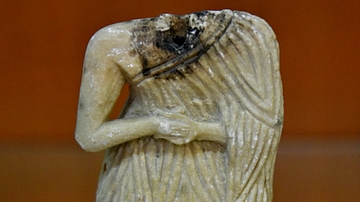
Image
Sumerian Woman from Khafajah
Limestone statue of a Sumerian female in a gesture of prayer. The head is lost but the color of a glue, which was used to join the head to the upper chest, is clear. The head was probably removed after some time, for some reason or another...
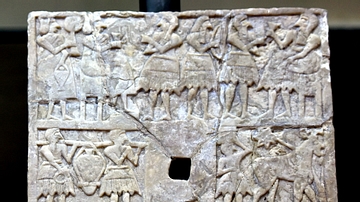
Image
Sumerian Votive Plaque from Khafajah
This limestone plaque was excavated by the Oriental Institute of the University of Chicago in the early 1930s, 1st season. It depicts three scenes in three registers. The upper register shows a banquet scene with musicians. The middle register...
![Statue of a Sumerian Male from Khafajah [Front View]](https://www.worldhistory.org/img/c/p/360x202/9678.jpg?v=1599123603)
Image
Statue of a Sumerian Male from Khafajah [Front View]
Limestone statue of a Sumerian male in a gesture of prayer. He wears the classical Sumerian flounced garment. The head/neck, right upper limb, and both feet are lost. Front view. From the Small Shrine at Khafajah (also Khafaje; ancient Tutub...
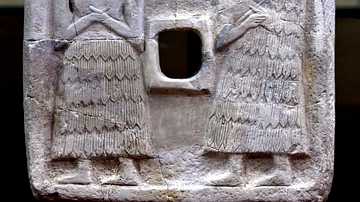
Image
Limestone Sumerian Plaque from Khafajah
This limestone plaque depicts two figures in relief. Cuneiform inscriptions appear at the upper part. It was excavated by the Oriental Institute of the University of Chicago in the early 1930s, 3rd season. The plaque dates back to the Early...
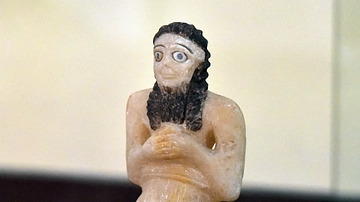
Image
Male Worshiper from Khafajah at the Iraq Museum
Statue of a Sumerian male worshiper from the hoard in Nintu Temple V at Khafajah (ancient Tutub), Mesopotamia, Iraq. Early Dynastic period, 2600-2400 BCE. Excavated by the Oriental Institute of the University of Chicago in the 1930s, 8th...
![Statue of a Sumerian Male from Khafajah [Rear View]](https://www.worldhistory.org/img/c/p/360x202/9681.jpg?v=1599123603)
Image
Statue of a Sumerian Male from Khafajah [Rear View]
Limestone statue of a Sumerian male in a gesture of prayer. He wears the classical Sumerian flounced garment. The head/neck, right upper limb, and both feet are lost. Back view. From the Small Shrine at Khafajah (also Khafaje; ancient Tutub...
![Statue of a Female Sumerian Worshipper from Khafajah [Front View]](https://www.worldhistory.org/img/c/p/360x202/9674.jpg?v=1618578907)
Image
Statue of a Female Sumerian Worshipper from Khafajah [Front View]
Limestone statue of a Sumerian female in a gesture of prayer. The eye sockets were filled in with white shell set in bitumen. She wears a Sumerian garment with a bare right shoulder. Front view. From the Temple of Sin, Khafajah (also Khafaje...
![Statue of a Sumerian Female from Khafajah [Front View]](https://www.worldhistory.org/img/c/p/360x202/9682.jpg?v=1599123603)
Image
Statue of a Sumerian Female from Khafajah [Front View]
Limestone statue of a Sumerian female in a gesture of prayer. The head is lost. She wears the classical Sumerian flounced garment with a bare right shoulder. The feet stand on a semi-rectangular base with a back-pillar. Front view. From the...